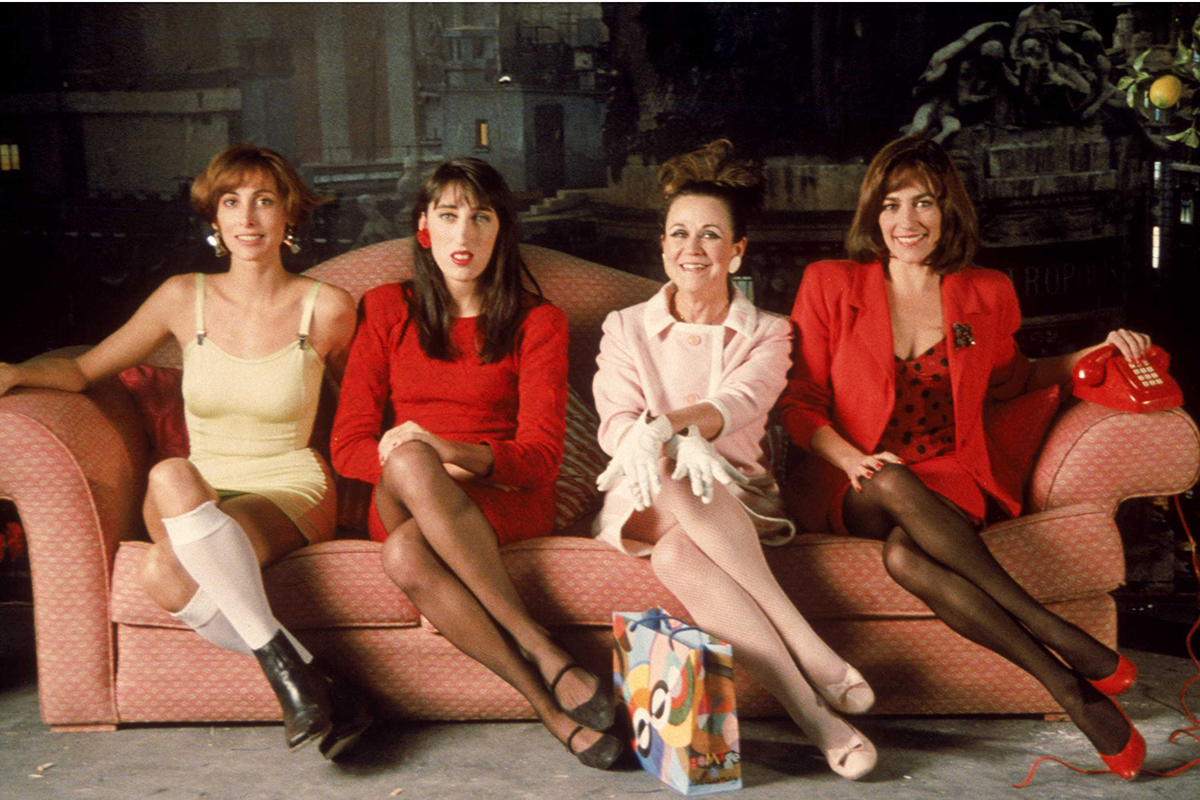“A woman’s brain is a mystery,” explains one man to another in Pedro Almodóvar’s Talk to Her. “You have to pay attention to women. Be thoughtful occasionally. Caress them. Remember they exist, they’re alive and they matter to us.” They matter to no one so much as the great Spanish film director. Almodóvar has flirted with exploring the emotional ebb and flow of homosexuality in his work, but for the most part he has pursued his veneration of the fairer sex. “Women are more spectacular as dramatic subjects,” he once explained. “They have a greater range of registers.”
The proof is in the film with which his name is above all associated. Women on the Verge of a Nervous Breakdown, a huge breakout hit in 1988, was Almodóvar’s Annie Hall. It introduced a male director who could make audiences all over the world laugh and cry and think about womanhood as more than just a binary adjunct of the male imagination: virgin or whore, pin-up or wallflower.
 Of course the title has much to do with the screwball comedy’s enduring appeal. It located the female sex, if not quite on the cusp of insanity, then certainly up at the more antic end of the emotional spectrum. You don’t go to Almodóvar for films about ladies keeping a lid on it. There were four of them on the memorable poster (pictured above). The leader of the pack was Pepe (played by the director’s original muse Carmen Maura), a dubbing artiste driven to distraction after she is abandoned by her lover. As she seeks him here, there and everywhere, she becomes enmeshed with the lives of both his unhinged wife Lucia and his snotty future daughter-in-law Marisa, as well as Candela, a suicidal model on the run from the police. “Women are not dangerous if you know how to handle them,” says the bottle-blond taxi driver who acts as Pepe’s charioteer and confessor. A fat lot he knows. In Almodóvar’s world women learn how to handle themselves, and one another.
Of course the title has much to do with the screwball comedy’s enduring appeal. It located the female sex, if not quite on the cusp of insanity, then certainly up at the more antic end of the emotional spectrum. You don’t go to Almodóvar for films about ladies keeping a lid on it. There were four of them on the memorable poster (pictured above). The leader of the pack was Pepe (played by the director’s original muse Carmen Maura), a dubbing artiste driven to distraction after she is abandoned by her lover. As she seeks him here, there and everywhere, she becomes enmeshed with the lives of both his unhinged wife Lucia and his snotty future daughter-in-law Marisa, as well as Candela, a suicidal model on the run from the police. “Women are not dangerous if you know how to handle them,” says the bottle-blond taxi driver who acts as Pepe’s charioteer and confessor. A fat lot he knows. In Almodóvar’s world women learn how to handle themselves, and one another.
The latest characters to appear in his ongoing gallery of womanhood in Julieta, which opens this month. The film tells of a middle-aged mother who abandons a plan to leave Madrid for a new life with a new man in Portugal when she hears word for the first time in years of her estranged daughter Antía. She is played with a lively flash of blonde hair by two Almodóvar newbies: as an older woman by Emma Suárez, and then in the extended flashback to her younger years which occupies much of the film, by Adriana Ugarte.
The film comes from an unusual Anglophone source for Almodóvar: three short stories by Alice Munro. And yet the travails of Julieta, a romance springing from a chance encounter on a train, a tragic death like something from a cheap telenovela, the intensity of the bonds between women, the incidental and transient role of the male characters, feel intensely Almodóvarian. Even one of its promotional posters (pictured below) is a deliberate echo of the imagery of Women on the Verge.

So who and what are these women in Almodóvar’s films? Above all they are great Spanish actresses. You can watch Maura grow old in them, see his middle-period muse Victoria Abril be pleasured by a toy scuba diver in the bath, witness him fetishise every curve of Penélope Cruz’s body. More than any of them, the gimlet-eyed Rossy de Palma has followed a through-line in his films across three decades from Laws of Desire (1987) to Julieta, in which she plays a possessive housekeeper.
But there are a lot more of than just beautiful faces. There are mothers and daughters, wives and girlfriends, whole girl gangs of resourceful, resilient females. Take Pepi, Luci, Bom (1980) his full-length debut. It tells of a trio who cover the boardwalk of Almodovarian femininity - vengeful rape victim, masochistic housewife and lesbian punk. Dark Habits (1983) is mostly set in a convent of indigent nuns whose mother superior is a lesbian drug addict. All About My Mother (1999) explores the alliances between a grieving mother, a pregnant nun, a lesbian actress and a transsexual prostitute. Volver (2006) plunges a knife into its main male character early on in order to concentrate on a story of three generations of women, all of them victims of male betrayal. “I’m at a difficult age,” says the youngest at one point. “You’re not the only one!” replies her aunt.
For Almodóvar, women are always at a difficult age. He is fond of placing them if not on the verge of a breakdown then on the edge of the society’s moral codes. Labyrinth of Passions (1982) features a nymphomaniac singer called Sexilia. Tie Me Up! Tie Me Down! (1990) tells of a trashy actress who falls in love with her kidnapper (not a popular film with feminists, that one). And then there are girls who are boys. In Laws of Desire Maura gives a wonderfully feminine performance as a woman who used to be a man. The light relief in the mostly tragic All About My Mother comes from Antonia San Juan as Agrado, the pre-op transsexual with a heart of gold who lists her surgical improvements. “You get to be more authentic,” she says, “the more you become like what you have dreamed of yourself.” (Below: Agrado's full speech about feminising her body).
Almodóvar dedicated the film to a trio of actresses from Hollywood’s yesteryear - Bette Davis, Romy Schneider and Gena Rowlands – but also “to all actresses who have played actresses, to all women who act, to men who act and become women, to all the people who want to be mothers”. That just about sums up the cast list of his entire oeuvre, give or take the lead roles for Antonio Banderas. He also dedicated the film to his own mother. Not to be left out of his extended company of actresses whose faces crop up over and over again in his work, she had a cameo in Kika (1993). She played as a poorly qualified television hostess who explains on air that she only got the job because her son is the director.
Just sometimes Almodóvar’s women are entirely the figments of the male imagination. That’s certainly how the director’s obsessive interest in the inner world of women began. In the 1970s he made short films which he’d screen in clubs. Without any soundtrack, he’d ventriloquise the voices himself live. In Talk to Her (2002) he silences his two heroines by putting them in a coma. Broken Embraces (2009) features Cruz as a kept woman who is subject to a tug of war between a director and a sugar daddy. In The Skin I Live In (2011) Banderas’s creepy scientist conjures up a beautiful woman from the body of a man.
These are films about the male desire to control women. But as the outrageous quartet in Women on the Verge of a Nervous Breakdown, that’s not how Almodóvar sees women. Not at all. In his world, from his beginnings all the way through to Julieta, they are their own creations.
- Read more about film on theartsdesk
- The Almodóvar Collection, a six-disc boxset featuring newly restored films from Almodóvar’s early career, will be released on DVD and Blu-ray on 19 September, with new interviews and extras. Preorder the collection
Overleaf: watch the trailer to Julieta and browse a gallery of Almodóvar's women
Almodóvar's women: click on the thumbnails to enlarge














Add comment